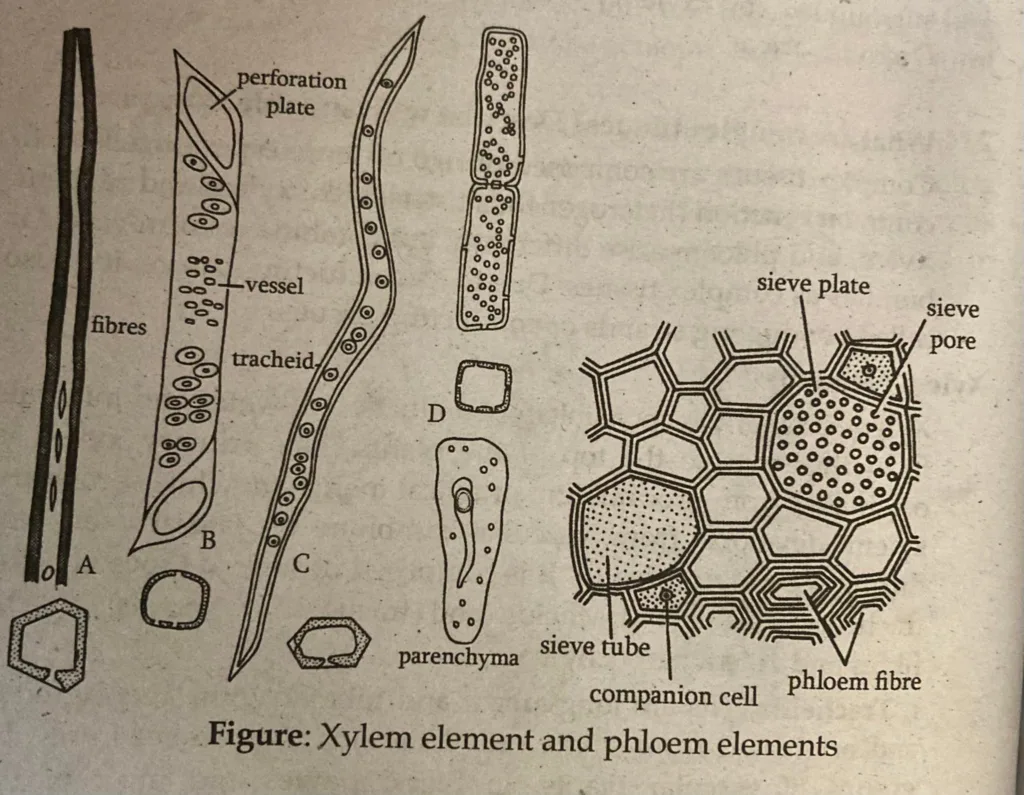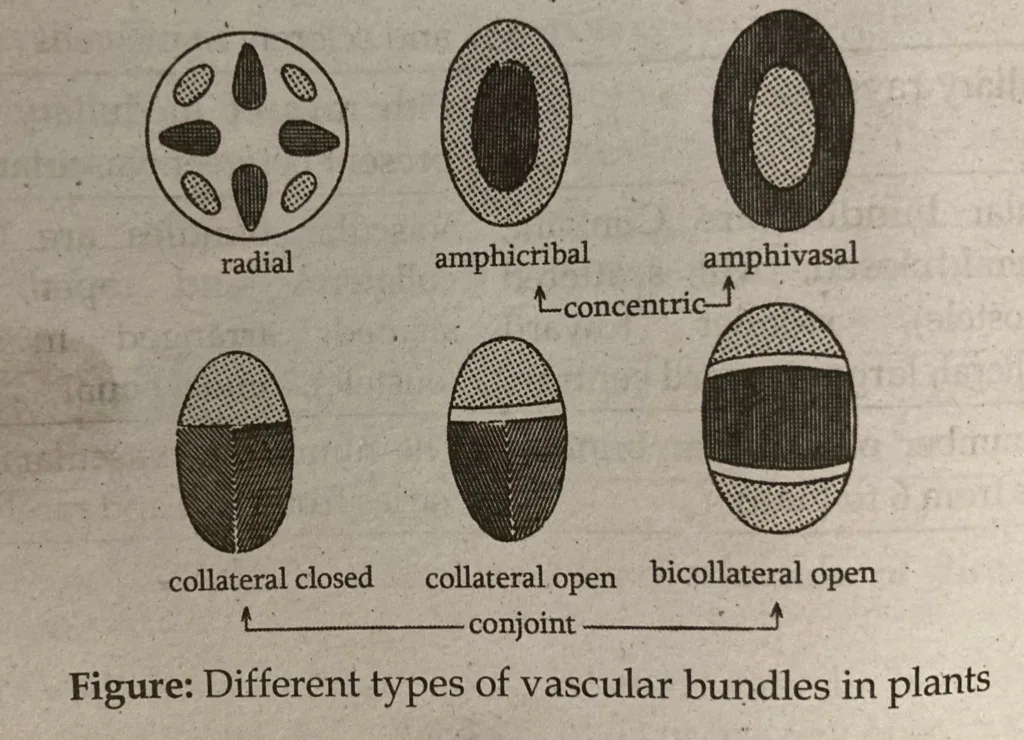Heterogenous tissues like xylem and phloem, which have two or more kinds of cells with a shared function, make up complex tissues. Phloem and xylem develop in distinct ways, but they unite to form complex tissues called vascular bundles. It is also known as connecting strands or conducting tissues because of its conductivity.Anatomy, Physiology and Differences of Xylem and Phloem will be studied under this article.
Xylem elements
Water and minerals are mostly transported from the roots to the top of plants through xylem. While secondary xylem grows from vascular cambium or lateral meristem during secondary growth, primary xylem is derived from procambium or the apical meristem. It is made up of xylem fibers, xylem parenchyma, and tracheary elements (tracheids and tracheae or vessels).
Tracheids:
The solitary cell that gave rise to the long, dead, tubular, and tapering tracheid cells. Each category of vascular plants has tracheids. Tracheids (without vessels) make up the whole tracheary portion of pteridophytes and the majority of gymnosperms. The primary functions of tracheids are mechanical support and water conduction.
Vessels:
Vessels are the chains of cells having characteristic perforation plate at their ends wall and joins end to end. It is formed by the dissolution of end walls of developing vessel members. It is shorter and broader than tracheids. The end wall may have one opening (simple perforation plate) or several openings (multiple perforation plate). At maturity, vessels don’t contain nucleus.
Xylem or wood fibers:
Long, thin cells called xylem have lignified secondary walls. It has tapering ends, is transversely septate, and is long and narrow sclerenchyma fibrous. Fiber tracheids and libriform fibers might be the culprit. Fiber tracheids offer mechanical strength and have bordered pits. Compared to tracheid fibers, libiform fibers are longer and have thicker walls; they also feature simple pits that aid in mineral and water conduction.
Xylem parenchyma:
Both primary and secondary xylem include thin-walled living cells known as xylem parenchyma. The wall may be lignified and exhibit bordered or plain pits. They might become sclereids or sclerotic cells after becoming sclerified.

Phloem elements
Phloem is primarily in charge of conducting or transporting organic food from the plant’s green or storage organs to other organs. Its other names include bast and leptome (Haberlandt). Procambium produces primary phloem, whereas vascular cambium creates secondary phloem. It comes in four main varieties: companion cells, phloem fibers, phloem parenchyma, and sieve elements (sieve cells, sieve
Sieve elements:
They are thin walled with characteristic sieve areas. It may be sieve tubes or sieve walls.
Long, thin sieve tubes that resemble tubes have specific sieve sections (sieve plates) that may be single or many. Without a nucleus, sieve tubes are filled with cytoplasm. Discrete bodies of a viscous P-protein may be seen in the sieve tubes. Fall is when callose (a soluble cellulosic polymer) builds up on and around sieve regions, forming plugs or pads that halt conducting action.
Sieve cells are elongated, narrow cells with tapering ends. Sieve areas occur all over the wall, but distinct sieve plate is not present. It is representative form of phloem in pteridophytes and gymnosperms.
Companion cells:
Companion cells are specialized parenchymatous, thin walled, narrow, attached to the lateral sides of sieve elements. Usually, single companion cell extends through whole length of sieve tubes; sometimes vertical file or one or more cells may find next to each sieve tube. The cytoplasm of companion cell is continuous with adjacent sieve tubes through plasmodesmata. The nucleus of companion cells also serves for the cytoplasm of associated sieve tubes that lack nucleus at maturity; hence, also termed sister cells. Companion cells are absent in pteridophytes and gymnosperms.
Phloem fibers (Bast fibers):
Phloem fibers have thick wall and narrow lumen and present in all tracheophyte. In primary structures, phloem fibers present in outer parts, while scattered in different way in secondary phloem. They provide mechanical support.
Phloem parenchyma:
These cells contain various substances like starch, tannins, crystals, mucilage, resins, etc. These are thin walled, living and commonly associated with fibers and sclereids.
Differences between Xylem and Phloem
| Parameter | Xylem | Phloem |
| Composition | Xylem consists of xylem parenchyma, xylem fibers, vessels and tracheids. | Phloem consists of phloem parenchyma, phloem fibers, companion cells and sieve tubes. |
| Life | It is dead element of vascular bundle. | It is living element of vascular bundle. |
| Three elements (vessels, tracheids, xylem fibers) are dead and one element (xylem parenchyma) is living. | Three elements (phloem parenchyma, companion cells, sieve tubes) are living and one element (phloem fibers) is dead. | |
| Function | Responsible for conduction of water and minerals. | Responsible for conduction of food materials. |
| Movement | Both upward and downward movements are common | Only upward movement is possible. |
| Mechanical tissue | Xylem parenchyma is only mechanical tissue | Phloem fibers is only mechanical tissue. |
| Wood development | It is major element for wood development | Does not help in wood formation |
| Secondary deposition | Secondary deposition produces different types of lignification. | Secondary deposition is not present. |
| Wall | All xylem elements have comparatively thicker wall | All phloem elements have comparatively thin wall |
Vascular bundles and its types
Vascular bundle is organized complex tissue with xylem and phloem elements with or without cambium. Based on the relative position of xylem and phloem, vascular bundles may be Radial, Conjoint, and Concentric.

Radial vascular bundle
It is a common type of vascular bundle found in roots. In radial vascular bundles, alternating patches of xylem and phloem elements occur in separate groups in two radii, e.g., characteristic of root.
Conjoint vascular bundle
It is a common type of vascular bundle found in stem. In stems, the xylem and phloem elements joined into one bundle, on the same radius forming one group; it may be conjoint collateral or conjoint bicollateral.
Conjoint collateral: In conjoint collateral vascular bundle, xylem and phloem lie together on the same radius: xylem being internal and phloem external. It may contain cambium (open) as in dicot and conifer gymnosperm stems or not (closed) as in monocot stems.
Conjoint bicollateral: In conjoint bicollateral vascular bundle, two phloem patches found internal and external to the centrally placed xylem. The outer group of phloem is external phloem and the inner phloem is internal phloem. There are two cambia: outer cambium between outer phloem and xylem and inner cambium between cambium and inner phloem. E.g., Cucurbitaceae, and some members of Solanaceae, Convolvulaceae, Apocynaceae, Myrtsceae, etc.
Concentric vascular bundle:
The concentric vascular bundles bear xylem and phloem elements in circles, one covering another and always closed type. It may be Amphicribal and Amphivasal. In Amphicribal (hadrocentric) vascular bundle, xylem occupies the center and surrounded by phloem, e.g., Lycopodium, Selaginella (pteridophytes), aquatic angiosperms and Dracaena (monocotyledons). In Amphivasal (leptocentric), vascular bundle, centrally located phloem is surrounded by xylem, e.g., secondary vascular bundles of Dracaena, Yucca etc.